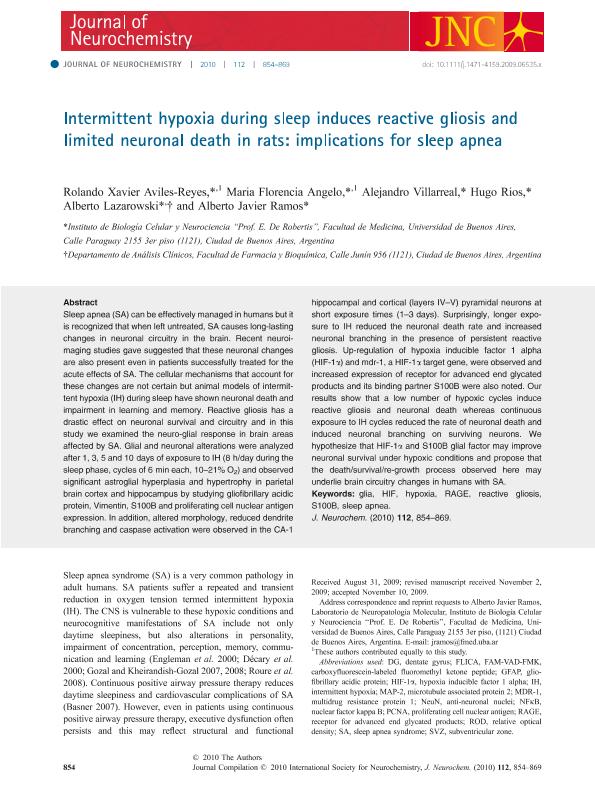Artículo
Intermittent hypoxia during sleep induces reactive gliosis and limited neuronal death in rats: Implications for sleep apnea
Aviles Reyes, Rolando Xavier ; Angelo, María Florencia
; Angelo, María Florencia ; Villarreal, Alejandro
; Villarreal, Alejandro ; Rios, Hugo
; Rios, Hugo ; Lazarowski, Alberto Jorge; Ramos, Alberto Javier
; Lazarowski, Alberto Jorge; Ramos, Alberto Javier
 ; Angelo, María Florencia
; Angelo, María Florencia ; Villarreal, Alejandro
; Villarreal, Alejandro ; Rios, Hugo
; Rios, Hugo ; Lazarowski, Alberto Jorge; Ramos, Alberto Javier
; Lazarowski, Alberto Jorge; Ramos, Alberto Javier
Fecha de publicación:
02/2010
Editorial:
Wiley Blackwell Publishing, Inc
Revista:
Journal of Neurochemistry
ISSN:
0022-3042
Idioma:
Inglés
Tipo de recurso:
Artículo publicado
Clasificación temática:
Resumen
Sleep apnea (SA) can be effectively managed in humans but it is recognized that when left untreated, SA causes long-lasting changes in neuronal circuitry in the brain. Recent neuroimaging studies gave suggested that these neuronal changes are also present even in patients successfully treated for the acute effects of SA. The cellular mechanisms that account for these changes are not certain but animal models of intermittent hypoxia (IH) during sleep have shown neuronal death and impairment in learning and memory. Reactive gliosis has a drastic effect on neuronal survival and circuitry and in this study we examined the neuro-glial response in brain areas affected by SA. Glial and neuronal alterations were analyzed after 1, 3, 5 and 10 days of exposure to IH (8 h/day during the sleep phase, cycles of 6 min each, 10-21% O2) and observed significant astroglial hyperplasia and hypertrophy in parietal brain cortex and hippocampus by studying gliofibrillary acidic protein, Vimentin, S100B and proliferating cell nuclear antigen expression. In addition, altered morphology, reduced dendrite branching and caspase activation were observed in the CA-1 hippocampal and cortical (layers IV-V) pyramidal neurons at short exposure times (1-3 days). Surprisingly, longer exposure to IH reduced the neuronal death rate and increased neuronal branching in the presence of persistent reactive gliosis. Up-regulation of hypoxia inducible factor 1 alpha (HIF-1α) and mdr-1, a HIF-1α target gene, were observed and increased expression of receptor for advanced end glycated products and its binding partner S100B were also noted. Our results show that a low number of hypoxic cycles induce reactive gliosis and neuronal death whereas continuous exposure to IH cycles reduced the rate of neuronal death and induced neuronal branching on surviving neurons. We hypothesize that HIF-1α and S100B glial factor may improve neuronal survival under hypoxic conditions and propose that the death/survival/re-growth process observed here may underlie brain circuitry changes in humans with SA.
Palabras clave:
GLIA
,
HIF
,
HYPOXIA
,
RAGE
,
REACTIVE GLIOSIS
,
S100B
,
SLEEP APNEA
Archivos asociados
Licencia
Identificadores
Colecciones
Articulos(IBCN)
Articulos de INST.DE BIOLO.CEL.Y NEURCS."PROF.E.DE ROBERTIS"
Articulos de INST.DE BIOLO.CEL.Y NEURCS."PROF.E.DE ROBERTIS"
Citación
Aviles Reyes, Rolando Xavier; Angelo, María Florencia; Villarreal, Alejandro; Rios, Hugo; Lazarowski, Alberto Jorge; et al.; Intermittent hypoxia during sleep induces reactive gliosis and limited neuronal death in rats: Implications for sleep apnea; Wiley Blackwell Publishing, Inc; Journal of Neurochemistry; 112; 4; 2-2010; 854-869
Compartir
Altmétricas



